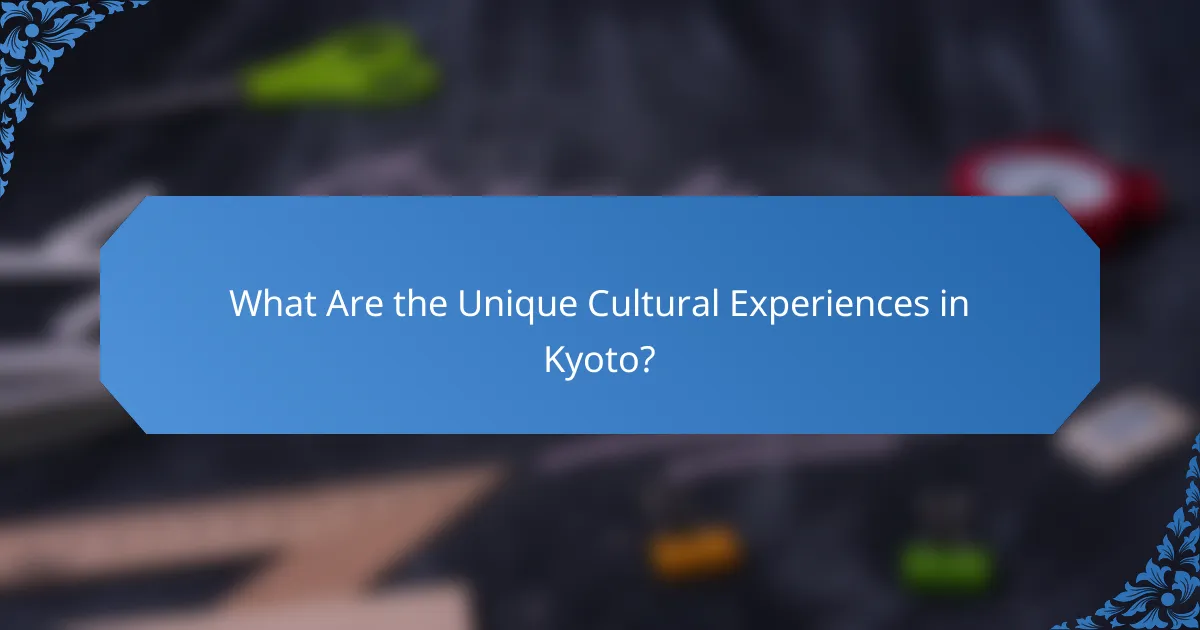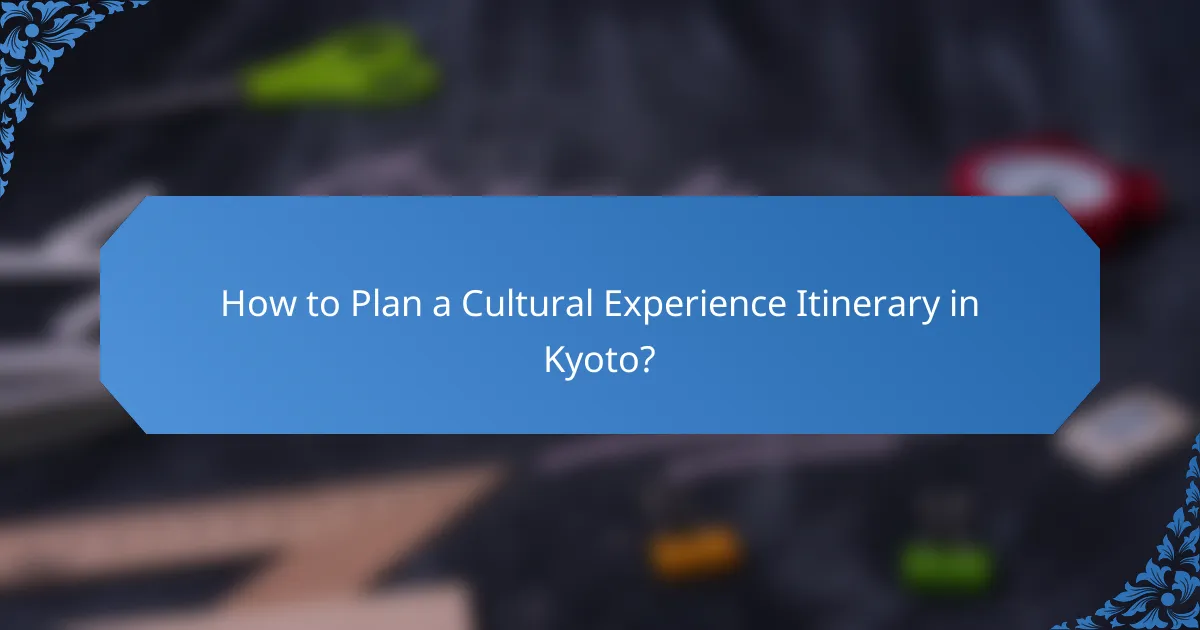Kyoto is a city where ancient traditions meet modern hospitality, offering a selection of boutique hotels that reflect its unique cultural heritage. Travelers can enhance their stay by engaging in local practices such as tea ceremonies, crafts, and festivals, providing a deeper connection to the city’s rich history. From geisha performances to zen meditation retreats, Kyoto invites visitors to immerse themselves in its vibrant cultural landscape.

What Are the Best Boutique Hotels in Kyoto?
Kyoto offers a range of boutique hotels that blend traditional Japanese aesthetics with modern comforts. These accommodations often provide personalized service and unique experiences, making them ideal for travelers seeking a more intimate stay.
Hotel Granvia Kyoto
Hotel Granvia Kyoto is conveniently located above Kyoto Station, making it an excellent choice for travelers. This hotel combines luxury with accessibility, featuring spacious rooms and stunning views of the city.
Guests can enjoy a variety of dining options, including Japanese and Western cuisines. The hotel also offers amenities such as a fitness center and a spa, ensuring a comfortable stay.
The Celestine Kyoto Gion
The Celestine Kyoto Gion is situated in the historic Gion district, known for its traditional wooden machiya houses and geisha culture. This boutique hotel emphasizes a serene atmosphere with its elegant design and tranquil gardens.
Rooms are designed with a blend of modern comfort and traditional aesthetics, featuring tatami mats and sliding doors. Guests can indulge in a kaiseki meal at the on-site restaurant, enhancing their cultural experience.
Kyoto Century Hotel
Kyoto Century Hotel is another excellent option, located near the city center and major attractions. This hotel offers a mix of contemporary style and traditional Japanese elements, appealing to both business and leisure travelers.
With spacious rooms and a range of dining options, including a buffet breakfast, it caters to various tastes. The hotel also provides easy access to public transport, making it convenient for exploring Kyoto.
Gion Hatanaka
Gion Hatanaka is a traditional ryokan that offers an authentic Japanese experience in the heart of Gion. Guests can enjoy staying in tatami-floored rooms and partake in traditional tea ceremonies.
The ryokan features a kaiseki restaurant, where guests can savor multi-course meals prepared with seasonal ingredients. Staying here allows for a deeper immersion into Kyoto’s rich culture and history.
Hotel Mume
Hotel Mume is a small, intimate boutique hotel located near Gion, known for its personalized service and attention to detail. Each room is uniquely designed, providing a cozy and luxurious atmosphere.
This hotel offers complimentary breakfast and a range of cultural experiences, such as guided temple visits. Its focus on guest satisfaction makes it a standout choice for those looking to enjoy Kyoto’s charm.

How to Experience Local Culture in Kyoto?
To truly experience local culture in Kyoto, immerse yourself in traditional practices and events that reflect the city’s rich heritage. Engaging in activities like tea ceremonies, exploring crafts, attending festivals, and visiting historic temples will provide a deeper understanding of Kyoto’s cultural landscape.
Participate in a Tea Ceremony
Joining a tea ceremony is a quintessential way to experience Kyoto’s culture. These ceremonies, known as “chanoyu,” emphasize harmony, respect, purity, and tranquility. Typically lasting about one to two hours, they involve the meticulous preparation and serving of matcha tea.
Look for tea houses that offer sessions in English, which can range from 3,000 to 10,000 yen per person. Be prepared to learn about the history and significance of the ritual, as well as the proper etiquette during the ceremony.
Explore Traditional Crafts
Kyoto is renowned for its traditional crafts, including pottery, textiles, and lacquerware. Visiting workshops allows you to see artisans at work and even try your hand at creating your own piece. Popular crafts include Kyo-yaki pottery and Nishijin textiles.
Many workshops offer short classes for beginners, typically costing between 5,000 and 15,000 yen. This hands-on experience not only supports local artisans but also gives you a unique souvenir to take home.
Attend a Local Festival
Experiencing a local festival is an excellent way to connect with Kyoto’s vibrant culture. Events like the Gion Matsuri in July and the Jidai Matsuri in October showcase traditional costumes, music, and parades. These festivals often feature food stalls and local crafts.
Plan your visit around these events, as they attract both locals and tourists. Check local schedules, as some festivals may require advance reservations for certain activities or seating.
Visit Historic Temples
Kyoto is home to numerous historic temples, each with its own unique architecture and cultural significance. Notable sites include Kinkaku-ji (the Golden Pavilion) and Kiyomizu-dera, both offering stunning views and serene environments.
When visiting, consider purchasing a temple pass that allows entry to multiple sites, typically costing around 1,000 yen. Take your time to explore the gardens and learn about the history of each temple, as they often host seasonal events and exhibitions that enhance the cultural experience.

What Are the Unique Cultural Experiences in Kyoto?
Kyoto offers a rich tapestry of cultural experiences that highlight its historical significance and traditional practices. Visitors can immerse themselves in the local culture through activities like geisha performances, zen meditation retreats, and kimono dressing experiences.
Geisha Performances
Geisha performances are a captivating way to experience Kyoto’s cultural heritage. These skilled artists, known as geiko in Kyoto dialect, showcase traditional music, dance, and games during private events or public performances. Attending a performance typically requires advance booking, especially in popular districts like Gion.
When planning to see a geisha performance, consider the type of experience you want. Options range from intimate tea ceremonies with a geisha to larger stage shows. Prices can vary significantly, often starting from around 10,000 JPY for smaller gatherings to over 30,000 JPY for exclusive events.
Zen Meditation Retreats
Zen meditation retreats in Kyoto provide an opportunity to practice mindfulness in serene surroundings. Many temples offer short retreats, ranging from a few hours to several days, where participants can learn the basics of zazen (sitting meditation) and engage in temple life.
To join a retreat, look for programs at well-known temples like Daitoku-ji or Nanzen-ji. Costs typically range from 5,000 JPY for a half-day session to 30,000 JPY for multi-day experiences, which may include accommodation and meals. It’s advisable to book in advance, especially during peak tourist seasons.
Kimono Dressing Experiences
Kimono dressing experiences allow visitors to wear traditional Japanese attire while exploring Kyoto’s historic sites. Many rental shops offer packages that include kimono selection, dressing assistance, and photography services. This experience not only enhances your visit but also provides a deeper connection to Japanese culture.
Prices for kimono rental can vary widely, typically starting around 3,000 JPY for basic rentals to 10,000 JPY or more for premium options. Consider visiting during weekdays to avoid crowds and ensure a more personalized experience. Some shops even provide guided tours to famous landmarks while dressed in kimono, enhancing the cultural immersion.

What Are the Criteria for Choosing a Boutique Hotel in Kyoto?
Choosing a boutique hotel in Kyoto involves considering factors like location, amenities, and guest feedback. These criteria help ensure a unique and comfortable stay that aligns with your travel preferences.
Location and Accessibility
Location is crucial when selecting a boutique hotel in Kyoto. Look for hotels situated near popular attractions such as Kinkaku-ji or Gion, which can enhance your cultural experience. Accessibility to public transport, like the subway or bus systems, is also important for convenient travel around the city.
Consider the neighborhood’s vibe as well; areas like Arashiyama offer a serene atmosphere, while downtown Kyoto is bustling with shops and restaurants. A central location can save you time and provide easy access to local culture.
Amenities and Services
Amenities can significantly impact your stay at a boutique hotel. Look for features such as complimentary breakfast, free Wi-Fi, and unique design elements that reflect Kyoto’s culture. Some hotels may offer traditional Japanese experiences, like tea ceremonies or kimono rentals.
Services such as concierge assistance can enhance your visit by providing local insights and recommendations. Ensure the hotel meets your needs, whether you prefer a spa, fitness center, or on-site dining options.
Guest Reviews and Ratings
Guest reviews and ratings are valuable resources when choosing a boutique hotel. Check platforms like TripAdvisor or Google Reviews for insights on cleanliness, service quality, and overall guest satisfaction. Look for hotels with consistently high ratings to ensure a positive experience.
Pay attention to recent reviews, as they provide the most current perspective on the hotel’s offerings. Consider both the quantity and quality of reviews; a hotel with numerous positive reviews is often a safer choice than one with only a few high ratings.

How to Plan a Cultural Experience Itinerary in Kyoto?
To plan a cultural experience itinerary in Kyoto, focus on selecting key attractions that showcase the city’s rich heritage and allocate sufficient time for each activity. This approach ensures a meaningful exploration of Kyoto’s unique traditions, temples, and local culture.
Identify Key Attractions
Start by listing must-see attractions that embody Kyoto’s cultural essence. Key sites include Kinkaku-ji (the Golden Pavilion), Fushimi Inari Taisha with its iconic torii gates, and the historic Gion district, known for its geisha culture. Consider visiting local markets like Nishiki Market for a taste of traditional cuisine.
Research each attraction’s significance and operating hours. Some sites may require advance reservations, especially during peak tourist seasons. Prioritize attractions based on your interests, whether they lean towards history, architecture, or culinary experiences.
Allocate Time for Each Activity
When allocating time for each activity, consider travel times between attractions and the time needed to fully appreciate each site. For instance, plan at least 1-2 hours for major temples and shrines, while local markets might only require an hour or so. Factor in breaks for meals and rest to avoid fatigue.
A practical tip is to group attractions by proximity to minimize travel time. For example, visiting Kiyomizu-dera and the surrounding streets can be done in half a day. Use a map or a travel app to visualize your itinerary and adjust as necessary to ensure a balanced experience.
